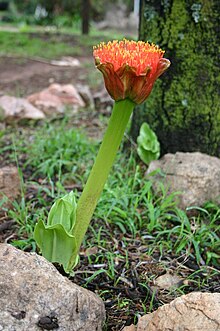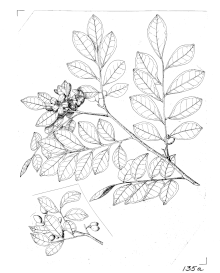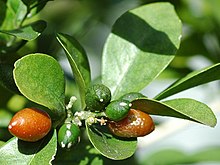Murraya paniculata, commonly called Orange Jessamine, is a
tropical,
evergreen plant bearing small, white, scented flowers, which is grown as an ornamental tree or
hedge.
Murraya is closely related to
Citrus, and bears small orange to red fruit resembling kumquats, though some
cultivars do not set fruit.
Synonyms and Common & Local Names
Taxonomical synonyms for
M. paniculata are:
- Chalcas exotica (L.) Millsp
- Chalcas paniculata L. (basionym)
- Murraya exotica L.
Some of the
common names include
Orange Jessamine,
Chinese box,
mock orange,
Mock lime,
satinwood ,
[1] or
Lakeview Jasmine (mainly in Florida)
Description

M. paniculata in flower pots
Orange Jessamine is a small, tropical, evergreen tree or shrub
growing up to 7 m tall. The plant flowers throughout the year. Its
leaves are
glabrous and glossy, occurring in 3-7 oddly
pinnate leaflets which are elliptic to cuneate-obovate to rhombic.
Flowers are terminal,
corymbose, few-flowered, dense and fragrant. Petals are 12–18 mm long, recurved and white (or fading cream). The fruit of
Murraya paniculata is fleshy, oblong-ovoid, coloured red to orange,
[3] and grows up to 1 inch in length.
[4]
Range
M. paniculata is a native of
South and
Southeast Asia,
China and
Australasia. It is naturalised in southern
USA.
[1]
Uses
Traditionally,
Murraya paniculata is used both in traditional medicine as an analgesic and for wood (for tool handles).
In the West,
Murraya paniculata is cultured as an ornamental tree or hedge because of its hardiness, wide range of soil tolerance (
M. paniculata may grow in
alkaline, clayey, sandy,
acidic and
loamy
soils), and is suitable for larger hedges. The plant flowers throughout
the years and produces small, fragrant flower clusters which attract
bees, while the fruits attract small
frugivorous birds.
[4]
Honey Bee farms have been known to plant Orange Jasmine near bee
hives. Serving not only as food for the bees but as protection from
harsh winds. Honey collected from bee hive colonies that collect pollen
from orange jasmines, have a tangy sweet orange undertone. Alternatives
for outdoor growth in colder climates would be a Gardenia bush.
Propagation
The Orange Jessamine is sexually
propagated by its seeds. The fruits are eaten by birds, who then pass the seeds out in their
stool. It may also be artificially propagated by softwood cuttings.
[4]
Diseases
M. paniculata is vulnerable to soil
nematodes, scales,
sooty mold and
whiteflies.
[4]
M. paniculata is the preferred host to the insect pest
Diaphorina citri, the
citrus psyllid. This psyllid is the vector for the
citrus greening disease.
[5]
Potential medicinal uses
The crude ethanolic extract of leaves of
Murraya paniculata has antidiarrhoeal, antinociceptive
[6] and anti-inflammatory activities.
[7] Yuehchukene, a dimeric indole alkaloid, can be extracted from the root.
www.veterinaria.uady.mx/ojs/index.php/TSA/article/view/1548
POTENTIAL DISTRIBUTION OF ORANGE JASMINE (Murraya paniculata) IN MEXICO
José López-Collado, J. Isabel López-Arroyo
Abstract
Orange jasmine (OJ) is a common ornamental plant used as green
hedge in public and private gardens in Mexico. It also hosts
Huanglongbing, a worldwide citrus disease and its vector, Diaphorina
citri. For risk analysis and management purpose is important to know its
geographic distribution. The potential distribution of OJ was
calculated in Mexico using a deductive approach. Based on temperature
and precipitation requirements, a relative suitability index was
computed by combining the normalized values of both variables. The
distribution was overlapped with captures of D. citri to check their
spatial similarity. The results showed that the potential of occurrence
is high in the Pacific and Gulf of México coastal states, including the
Yucatán peninsula, and the lowest values appeared in the north-western
states. The OJ distribution overlaps with Huanglongbing occurrence and
coincided with captures of D. citri for most of the suitable area but D.
citri captures extended beyond the optimal OJ distribution values in
the northern regions of México.
Full Text:
PDF





